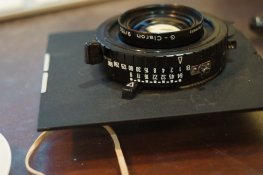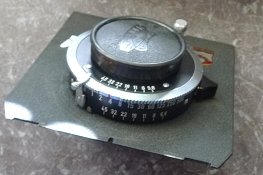In answer to post #14
Linear Spacing of Aperture Scale
Note: This assumes that whole stop positions are uniformly spaced along the travel of the aperture lever. This is the case with the lens shutters that I’ve examined.
Let the aperture numbers span a distance s along the flat aperture scale. Suppose that the range of f-stops is r. For example, if the scale began at f/8 and extended to f/64 we’d have 7 whole-stop aperture positions for a range of r = 6 stops.
If the liner distance from f/8 to f/64 was s = 36mm, then the distance between whole-stop positions is 36mm/6 = 6mm. This gives us the generalization
d = s/r
where d = distance between full-stop markings
s = the linear span or travel of the aperture lever from maximum to minimum aperture
r = range of stops (number of stops from maximum to minimum for the lens)
In the case of a lens whose aperture lever adjusts the iris from f/9 to f/64, the range r = 5 2/3 stops or r = 17/3 stops. Then
d = (36mm)/(17/3) = 36mm*(3/17) = 6.35mm [The distance between whole stops]
The distance between f/9 and f/11 is only 2/3 stops, or 2/3 of the whole-stop distance.
[Note: I don’t know the linear travel of the aperture lever for this lens and shutter combination, so the assumption of s = 36mm is fictional but gives us a concrete value for the example.]
d’ = (2/3)*6.35mm = 4.24mm
Let’s see if these distances add correctly.
5*6.35mm + 4.24mm = 36mm
The positions for 1/2 stops, 1/3 stops, and so forth can be worked out similarly.
We could also do this for the angular displacement of the aperture lever if wanted.




